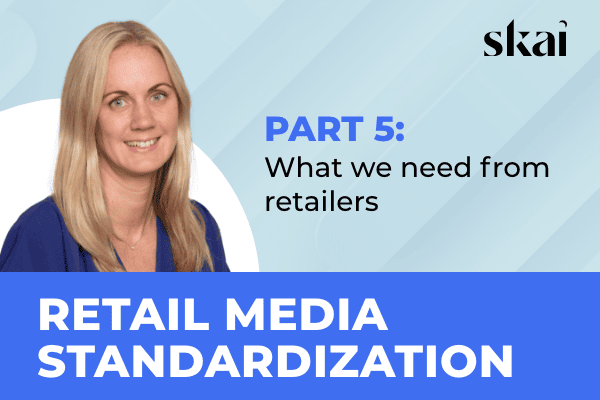In modern marketing, businesses constantly seek innovative ways to engage customers and drive revenue growth. Enter retail media, a game-changing advertising strategy that empowers retailers to monetize their digital assets and customer data by offering targeted advertising opportunities to brands. This symbiotic relationship between retailers and brands has the potential to revolutionize the advertising landscape and create a win-win situation for all parties involved.
As ecommerce continues to dominate the retail industry, retail media has emerged as a powerful tool for retailers looking to stay ahead of the curve. Understanding their customers through first-party data and crafting personalized shopping experiences allows retailers to unlock new revenue streams and build stronger customer relationships.
The Rise of Retail Media
The growth of the retail media space can be attributed to several factors, including the increasing importance of ecommerce, the decline of traditional advertising channels, and the need for retailers to find new revenue streams. According to Skai, in 2023, retail media was thriving, with 77% of marketers reporting positive outcomes and only 3% experiencing poor results. This consistent value is set to keep marketer investment flowing in 2024 and beyond.
As retail media continues to evolve, it is expanding in every direction:
- Moving up the funnel with more focus on video and CTV advertising
- Proliferating off-site display ads
- Attracting non-endemic advertisers
- Offering innovative in-store opportunities
- Forging partnerships with social publishers
Retailers are well-positioned to capitalize on the retail media trend due to their:
- Access to valuable first-party customer data
- Ability to create personalized shopping experiences
- Established relationships with brands and advertisers
Despite some skepticism about its longevity and challenges like data privacy and lack of standardization, the sentiment around retail media remains largely positive. Marketers have indicated that transparency, control, and reduced complexity are their primary needs rather than standardization.
Interestingly, retail marketers have nearly tripled their channel coordination priority, from 17% in 2023 to 47% in 2024. Measuring incrementality also remains challenging, underscoring the need for continued education and rigorous testing. To navigate the complexities of retail media, 58% of marketers are leveraging technology, such as business intelligence tools.
As more retailers invest in retail media capabilities and address these challenges, it is clear that this advertising strategy will continue to shape the future of the retail industry.
Still confused about retail media? Read our blog, What is Retail Media, for more information.
The Importance of Retail Media Networks
Retail media networks have emerged as a key component of the retail media landscape. These networks are advertising platforms created by retailers to monetize their digital properties and first-party customer data. By establishing their own media networks, retailers can offer brands and advertisers unique opportunities to reach and engage with their customers.
Some notable examples of retail media networks include:
- Amazon Advertising
- Walmart Connect
- Target Roundel
- Kroger Precision Marketing
- CVS Media Exchange
These networks allow retailers to create and manage their own advertising inventory, such as sponsored product listings, display ads, and native content. Brands can then purchase advertising space on these networks to promote their products and reach relevant audiences.
Retail media networks offer several advantages for both retailers and advertisers:
- First-Party Data: Retailers have access to valuable first-party customer data, which can be used to create highly targeted and personalized advertising experiences.
- Closed-Loop Attribution: Retail media networks provide a closed-loop attribution model, allowing advertisers to directly measure the impact of their campaigns on sales and other key metrics.
- Contextual Relevance: Ads served through retail media networks are inherently contextual, as they are displayed alongside relevant products and categories, leading to higher engagement and conversion rates.
- Incremental Revenue: Retail media networks provide retailers with an additional revenue stream, allowing them to monetize their digital assets and offset the costs of ecommerce operations.
As retail media continues to grow, the importance of retail media networks is likely to increase. Retailers that can successfully establish and scale their own media networks will be well-positioned to capture a larger share of advertising dollars and strengthen their relationships with brands.
Ready to boost sales and brand awareness? Explore the benefits of retail media spend.
The Multifaceted Benefits of Retail Media
Retail media offers a treasure trove of advantages for retailers, brands, and consumers alike. Leveraging the power of first-party data, personalization, and contextual relevance, retail media has the potential to reshape the advertising landscape and generate value for all stakeholders.
Consider these benefits:
Unlocking Revenue Streams and Boosting Profitability
One of the most significant benefits of retail media is its ability to create new revenue streams for retailers. Monetizing their digital assets and rich first-party customer data, retailers can establish a fresh and profitable revenue stream that complements their core business. This additional income can be used to offset the costs of running an e-commerce operation, invest in innovation, and improve the overall customer experience.
Retail media also provides a cost-effective marketing solution for retailers looking to promote their own private-label products and drive traffic to high-margin categories. With their own channels and data at their disposal, retailers can optimize their ad spend and achieve a higher return on investment compared to traditional advertising methods.
Delivering Personalized and Engaging Consumer Journeys
Retail media empowers retailers to craft highly personalized and engaging shopping experiences for customers. Leveraging the power of first-party data, retailers can deliver targeted advertising content that resonates with individual shoppers, leading to increased engagement, conversion rates, and customer satisfaction.
Personalization can take many forms, such as:
- Product recommendations based on browsing and purchase history
- Targeted offers and promotions tailored to specific customer segments
- Customized content and messaging that speaks directly to individual needs
By providing relevant and valuable advertising experiences, retailers can foster stronger customer connections and build long-term brand loyalty.
Gaining Valuable Insights and Driving Data-Driven Strategies
Retail media provides retailers access to a wealth of first-party customer data, offering invaluable insights into consumer behavior, preferences, and purchase patterns. These insights can inform strategic decision-making across various aspects of the business, from product development and merchandising to pricing and marketing.
Leveraging advanced analytics and data visualization tools, retailers can:
- Identify high-value customer segments and tailor their offerings accordingly
- Optimize product placement and assortment on the digital shelf based on real-time demand
- Develop targeted marketing campaigns that drive measurable results
- Continuously refine and improve their retail media strategies based on data-driven insights
The ability to make data-driven decisions is a key competitive advantage in the fast-paced world of retail, and retail media provides the necessary foundation for this approach.
Strengthening Partnerships and Driving Incremental Value for Brands
Retail media creates new opportunities for retailers to collaborate with brands and drive mutual growth. By offering brands access to their valuable first-party data and engaged customer base, retailers can help them achieve their marketing goals and drive incremental sales.
Retail partnerships can take many forms, such as:
- Sponsored product placements and promotions within the digital shelf
- Co-branded content and experiences that resonate with both audiences
- Exclusive product launches and collaborations that generate excitement
- Joint marketing campaigns and events that reach a wider audience
By working together to create compelling advertising options, retailers and brands can build stronger relationships and unlock new sources of value for their respective businesses.
Enhancing the Omnichannel Experience and Driving In-Store Traffic
Retail media can play a significant role in bridging the gap between online and offline shopping experiences. Promoting in-store offerings and events through digital channels helps retailers draw customers to their physical locations, boosting foot traffic and sales.
Some examples of how retail media can enhance the omnichannel experience include:
- Promoting in-store exclusives and limited-time offers through targeted digital advertising
- Using location-based targeting to drive customers to nearby stores
- Offering personalized product recommendations and coupons for in-store redemption
- Creating immersive and interactive digital experiences that complement in-store shopping, like virtual tours or product demonstrations
Seamlessly integrating retail media across online and offline touchpoints creates a cohesive and engaging customer journey for retailers. This, in turn, fosters long-term loyalty and growth.
The benefits of retail media are vast and far-reaching, offering retailers a powerful tool to drive revenue, deepen customer relationships, and gain a competitive edge in an increasingly digital world. As the retail industry continues to evolve, those who can effectively harness the potential of retail media will be well-positioned for success in the years to come.
Unlock Retail Media Growth with Skai: Your True Marketing Partner
Fuel your retail media success with Skai, the all-in-one platform powering smarter marketing decisions. We combine data, AI, and a suite of powerful tools to help you understand your audience, dominate the digital shelf, and achieve superior results.
Here’s what sets Skai apart:
- Unified Omnichannel Platform: Break down data silos and gain a holistic view of your campaigns across all major retail media channels.
- Marketing Measurement Expertise: Go beyond basic metrics. With Skai, you can measure the true impact of your marketing efforts using privacy-compliant solutions.
- Future-proofed for Privacy: As data privacy regulations evolve, Skai’s solutions stay compliant, ensuring you can continue to optimize your campaigns.
- Rich Retail Media Capabilities: Maximize your ROI on booming retail media platforms with Skai’s industry-leading suite of tools.
- AI-powered Optimization: Leverage cutting-edge AI to automate tasks, generate creative assets, and optimize bids for maximum impact.
- Independent Platform Flexibility: Integrate any data source you need with Skai’s open and flexible architecture.
Skai isn’t just a platform; it’s a partnership. We provide the tools and expertise you need to thrive. Our dedicated team of specialists will work alongside you to understand your unique goals and develop a winning retail media strategy. With Skai, you have a trusted partner invested in your success.
Ready to unlock your retail media potential? Contact us today!
Frequently Asked Questions
What types of retailers can benefit from retail media?
Retail media can benefit a wide range of retailers, from grocery and department stores to online marketplaces and specialty retailers. As long as a retailer has a significant digital presence and a substantial customer base, they can potentially benefit from implementing a retail media strategy.
How does retail media differ from traditional advertising channels?
Retail media offers a more targeted, personalized, and measurable approach to advertising compared to traditional channels. By utilizing first-party customer data and native advertising formats, retail media delivers a more relevant and engaging advertising experience while providing a closed-loop attribution model that allows retailers to directly measure the impact of their advertising efforts on sales and customer behavior.
What are the key metrics to measure the success of retail media campaigns?
Key performance indicators (KPIs) for retail media campaigns include return on ad spend (ROAS), click-through rate (CTR), conversion rate, average order value (AOV), and customer lifetime value (CLV). Retailers should collaborate with their brand partners to establish clear goals and metrics for each campaign and regularly monitor and optimize performance based on these KPIs.






